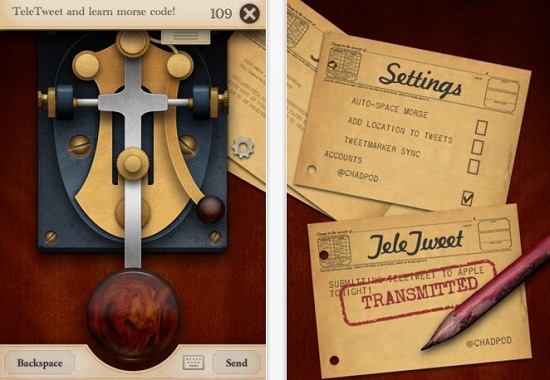We have seen many crazy inventions that let you post a tweet through a machine that requires you to enter each letter via Morse code. This is an awesome way to not only learn a new method of sending messages, but is also an interesting nod to the past. Even though mainstream society doesn’t use it on a day-to-day basis, it’s still a pretty neat idea.
However, if we want to use this method, it might be a bit difficult to lug around the entire telegraph. Should you want to dabble in learning Morse code, maybe the TeleTweet app is worth a gander? Costing a mere $0.99, you can dot and dash your way through a tweet in no time at all. Well, after you’ve learned the ropes of course. There are settings to make things a bit easier for newcomers, such as auto-space, and features such as adding locations and using multiple accounts.





I'm an old Airborne Radio Operator, trained in International Morse Code at speed, and while this twitter ap is an interesting fun novelty, I can't see it replacing texting. It is necessary for both sender and receiver to know the patterns of dots and dashes that form the code, and unless they are very fast, texting is faster.
Example– to send " LOL" texting requires pressing 3 keys, while in Morse, it is necessary to tap the key 11 times. Morse Code was replaced because it's much faster to talk on a radio than using the code. Not to mention that even for the bright young people, it takes months to learn the code and develop useful speed– upwards of 20 words per minute, two to 3 letters a second.
The implication that Morse "code" would be secure is false. A cell phone is not a phone at all–it's a single-sideband super hetrodyne radio transceiver broadcasting to the world, and can be hacked and traced (or jammed) like any other radio transmission.
.
Aww…you're spoiling all the fun! :)
di da dit didadidadit
I've just spent far too long trying to work out what that means. :)
Like Chuck, (an old flybuddy of mine), I too was an airborne R.O. With respect to transmission speed, I agree with Chuck. At the time of the manual handset, there was an item referred to as a speed key – a deflection to the left produced nothing but high-speed dots, while a deflection to the right resulted in high-speed dahs. While much faster than the handset, it's still slower than texting. dit dit dit dit dit dah dit dah dah dah dah dah dit dit dah.
Jim — di dah di is R–Roger and di dah di dah dit is AR run together without a pause between the A and the R. It is the Morse character for "End Transmission" or the spoken word "Out." In the radio log The AR was written overscored.
__
AR
__
There are other others– dah dit dit dit dah is BT, denoting the word "Break."
You can see why it would take a while for the texters to learn the code.
Awesome, I love this stuff! :) So romantic, in a black and white 50's movie kind of way. :)
Sorry — I meant the explaination for Nigel– Jim obviously knows the code. There is another thing about the code– radio operators can recognize the sender just by the sound of his "fist"– the unique way in which he taps out the dots and dashes. It wasn't uncommon for ROs to become friends over the air without ever physically meeting each other — very similar to E-mail.
It is very possible that I too know ''Scamp'' as I too was a radio operator back when. Went through radio school in the same class as Chuck.
I agree with both of them. It was great technology ''back when'' but it was replaced by technology for a reason. My job was replaced by a modern radio.
Max